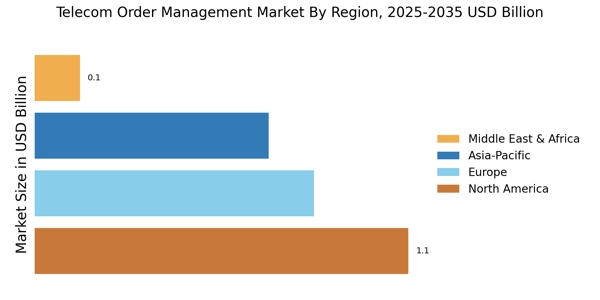The Telecom Order Management Market is currently characterized by a dynamic competitive landscape, driven by rapid technological advancements and increasing demand for efficient service delivery. Key players such as Amdocs (IL), Oracle (US), and Ericsson (SE) are strategically positioning themselves through innovation and partnerships to enhance their operational capabilities. Amdocs (IL) focuses on digital transformation initiatives, aiming to streamline order management processes for telecom operators, while Oracle (US) emphasizes cloud-based solutions to improve scalability and flexibility in service delivery. Ericsson (SE), on the other hand, is investing heavily in 5G technologies, which are expected to redefine order management frameworks in the telecom sector. Collectively, these strategies indicate a shift towards more integrated and customer-centric service models, shaping a competitive environment that prioritizes agility and responsiveness.
In terms of business tactics, companies are increasingly localizing their operations and optimizing supply chains to enhance efficiency and reduce costs. The market structure appears moderately fragmented, with several players vying for market share, yet the influence of major companies remains substantial. This competitive structure fosters innovation, as smaller firms often collaborate with larger entities to leverage advanced technologies and expand their market reach.
In August 2025, Amdocs (IL) announced a strategic partnership with a leading telecom operator to implement an AI-driven order management system. This initiative is poised to enhance customer experience by automating order processing and reducing turnaround times. The integration of AI technologies signifies a critical step towards operational excellence, allowing Amdocs (IL) to differentiate itself in a crowded market.
Similarly, in September 2025, Oracle (US) launched a new suite of cloud-based order management solutions tailored for telecom providers. This launch is significant as it aligns with the growing trend of digital transformation within the industry, enabling telecom companies to adapt quickly to changing market demands. By offering scalable solutions, Oracle (US) positions itself as a leader in facilitating the transition to cloud-based operations, which is increasingly vital in today’s fast-paced environment.
In October 2025, Ericsson (SE) unveiled its latest 5G order management platform, designed to streamline service provisioning for telecom operators. This development is particularly noteworthy as it underscores Ericsson's commitment to leveraging next-generation technologies to enhance operational efficiency. The introduction of this platform is likely to set new benchmarks in the industry, emphasizing the importance of technological innovation in maintaining competitive advantage.
As of October 2025, the Telecom Order Management Market is witnessing trends that emphasize digitalization, sustainability, and AI integration. Strategic alliances among key players are increasingly shaping the competitive landscape, fostering collaboration that enhances technological capabilities. Looking ahead, it is anticipated that competitive differentiation will evolve, with a pronounced shift from price-based competition to a focus on innovation, technology, and supply chain reliability. This evolution suggests that companies that prioritize these aspects will likely emerge as leaders in the Telecom Order Management Market.


















Leave a Comment